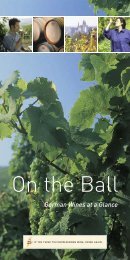the magazine of the german wine institute - Wines of Germany
the magazine of the german wine institute - Wines of Germany
the magazine of the german wine institute - Wines of Germany
You also want an ePaper? Increase the reach of your titles
YUMPU automatically turns print PDFs into web optimized ePapers that Google loves.
48<br />
GERMAN WINE GROWING REGIONS<br />
Rhein<br />
���������������<br />
����������� ������������<br />
��<br />
Stuttgart<br />
�����������<br />
Neckar<br />
Meersburg<br />
�<br />
��������<br />
Vineyard area:<br />
ca. 11,500 ha,<br />
71% red <strong>wine</strong><br />
Most important grape varieties:<br />
Trollinger, Riesling,<br />
Schwarzriesling, Lemberger<br />
Fur<strong>the</strong>r information:<br />
www.wwg.de<br />
Sparkling <strong>wine</strong> manufacturer<br />
Kessler in Esslingen<br />
Hornberg castle<br />
in Neckarzimmern<br />
Pfedelbach and <strong>the</strong> barrel<br />
<strong>of</strong> <strong>the</strong> prince<br />
Sommeliers,<br />
<strong>wine</strong> connoisseurs,<br />
and people living<br />
in <strong>the</strong> growing areas<br />
know that <strong>the</strong>re is an appropriate glass for every<br />
type <strong>of</strong> <strong>wine</strong>. In Württemberg, this is a very strange<br />
receptacle: a glass mug. The only <strong>wine</strong> glass without<br />
a stem has a convenient handle on its side and is<br />
mostly used in <strong>the</strong> traditional <strong>wine</strong> taverns. In general,<br />
<strong>the</strong> inhabitants <strong>of</strong> Württemberg drink more<br />
<strong>wine</strong> than <strong>the</strong> people in all <strong>the</strong> o<strong>the</strong>r regions<br />
in <strong>Germany</strong>.<br />
IT COMES AS NO SURPRISE that <strong>the</strong> state <strong>of</strong> Baden-<br />
Württemberg is home to <strong>the</strong> two <strong>wine</strong>-growing<br />
regions Baden and Württemberg both <strong>of</strong> which<br />
with <strong>the</strong>ir own character.<br />
With around 11,500 hectares under vine Württemberg<br />
is <strong>the</strong> fourth largest German <strong>wine</strong>growing<br />
region. Red grapes predominate here,<br />
with a share <strong>of</strong> 71 percent. And this is not only<br />
<strong>the</strong> palatable Trollinger: o<strong>the</strong>r favourites <strong>of</strong><br />
<strong>the</strong> Württemberg vintners are Pinot Meunier<br />
(Schwarzriesling), Lemberger and Pinot Noir<br />
(Spätburgunder). Not to forget Riesling which<br />
is grown on about 2,000 hectares and is <strong>the</strong> most<br />
important white <strong>wine</strong> variety in Württemberg.<br />
The <strong>wine</strong>-growing area <strong>of</strong> Württemberg is located<br />
on <strong>the</strong> river Neckar and on its tributaries<br />
Rems, Enz, Tauber, Kocher and Jagst. A Württemberg<br />
<strong>wine</strong> enclave also includes <strong>the</strong> vineyards<br />
<strong>of</strong> <strong>the</strong> Bavarian banks <strong>of</strong> Lake Constance near<br />
Lindau.<br />
THE HILLY LANDSCAPE ALONG ITS RIVERS IS<br />
EVIDENCE OF THE GEOLOGICAL HISTORY OF WÜRT-<br />
TEMBERG.<br />
The volcanic origin <strong>of</strong> many a hill can be seen in<br />
its cone shape. Five kilometres east <strong>of</strong> Heilbronn<br />
is Weinsberg which is <strong>the</strong> seat <strong>of</strong> <strong>the</strong> prestigious<br />
National Training and Research Institute for<br />
<strong>wine</strong> and fruit growing. Important grape varieties<br />
like Kerner and Dornfelder have been bred<br />
here.<br />
In Württemberg <strong>wine</strong> was considered a “staple<br />
food” for a long time – just like beer in Bavaria.<br />
Until <strong>the</strong> First World War <strong>the</strong> smallest meas-<br />
ure <strong>of</strong> <strong>wine</strong> available in a pub was a “Schoppen”<br />
which is half a litre. Most <strong>of</strong> <strong>the</strong> <strong>wine</strong> produced<br />
in Württemberg is consumed locally, particularly<br />
in cosy countryside <strong>wine</strong> taverns which are<br />
run by <strong>the</strong> vintners and only open during <strong>the</strong><br />
summer season.<br />
The system <strong>of</strong> <strong>wine</strong> cooperatives is firmly rooted<br />
in Württemberg. Many vintners or vine dressers<br />
as <strong>the</strong>y are called here in Württemberg are parttime<br />
<strong>wine</strong>-growers who deliver <strong>the</strong>ir grapes to<br />
cooperatives. Of course <strong>the</strong>re are also many <strong>wine</strong>ries<br />
in <strong>the</strong> region that market <strong>the</strong>ir <strong>wine</strong>s <strong>the</strong>mselves.<br />
A speciality is <strong>the</strong> Schillerwein. Unlike o<strong>the</strong>r<br />
rosé <strong>wine</strong>s Schillerwein is made from a mixture<br />
<strong>of</strong> red and white grapes which are already mixed<br />
toge<strong>the</strong>r prior to fermentation. The term<br />
“Schillerwein” has nothing to do with <strong>the</strong> great<br />
Württemberg poet Friedrich Schiller but probably<br />
has its origins in <strong>the</strong> Middle Ages.<br />
page right:<br />
view <strong>of</strong> <strong>the</strong> Neckar from Hornberg<br />
Castle<br />
small photos above:<br />
bottle store at <strong>the</strong> sparkling <strong>wine</strong><br />
manufacturer Kessler (left),<br />
romantic timber-framed buildings<br />
in Niedernhall



